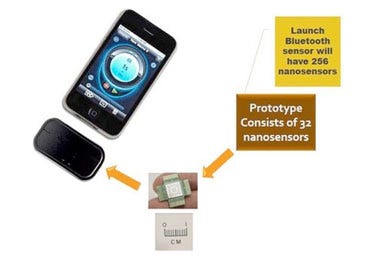Nanotechnology Tapped For Blood Glucose Breathalyzers
November 13, 2013
Western New England University researchers have turned to nanometer-thick films and polymers to create a breathalyzer to detect blood-glucose levels in the breath of diabetics.
Researchers unveiled the technology this week at the 2013 American Association of Pharmaceutical Scientists (AAPS) Annual Meeting and Exposition in San Antonio, TX.
The news comes months after University of Pittsburgh announced a new breathalyzer.
|
"The breathalyzer we currently have is about the size of a book, but we're working with an engineer, Dr. Michael Rust at Western New England University, to make it smaller, more similar to the size of a breathalyzer typically used to detect blood alcohol content levels," says RonnyPriefer, professor of medicinal chemistry of Western New England University and lead researcher. |
The Western New England University team is using two polymers that react with acetone in the nanometer-thick films. Besides creating the fruity breath odor that is one of the early symptoms of diabetes, acetone is correlated with higher-than-normal blood glucose levels.
The crosslinked polymers react and alter the he physicochemical nature of the film, which provides an acetone measurement. The technology could potentially provide an alternative to finger prick tests, but there are size issues to work out for now.
"The breathalyzer we currently have is about the size of a book, but we're working with an engineer, Dr. Michael Rust at Western New England University, to make it smaller, more similar to the size of a breathalyzer typically used to detect blood alcohol content levels," says Ronny Priefer, professor of medicinal chemistry of Western New England University and lead researcher.
The University of Pittsburgh team's technology meanwhile involved combined carbon nanotubes with titanium dioxide. The materials were used to create an electrical semiconductor. The breathalyzer's sensor measures electrical resistance and translates it into a blood glucose level.
A Stony Brook University team has created a breathalyzer with a sensor chip that can detect diseases and disorders like diabetes, high cholesterol and lung cancer, according to a PBS report.
Chris Newmarker is senior editor of MPMN and Qmed. Follow him on Twitter at @newmarker and Google+.
About the Author(s)
You May Also Like

.png?width=300&auto=webp&quality=80&disable=upscale)

